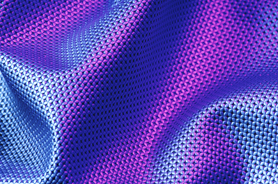Does “acoustic fabric” really exist ? We at Sontext get calls every week from designers asking , “We need sound absorbing panels on our project – how do we know if the fabric we want to use can be used on Acoustic Panels? “. Some fabric or textile manufacturers actually quote their fabrics as “Acoustic“, but what does that mean?. While the fabric may be suitable for use on Acoustic Panels as a decorative facing it does not mean that the fabric is suitable acoustically. In fact a fabric may actually detract from the performance of the sound absorbing material in an Acoustic Panel. What is important in choosing a fabric or textile covering for an Acoustic Panel? Basically, a fabric or textile must allow air to pass through, to determine whether it is acoustically transparent or not. There is a technical measure for this property, called Flow Resistivity. Some manufacturers do quote this figure on their data sheets. As an example, suede or leather may look outstanding as a facing on Acoustic Panels, but these materials are not breathable,- they do not let air pass through to the sound absorbing insualtion under the face. They can also alter the dynamics of the sound reaching the panel surface. However, the sound absorption of these materials can be altered by perforating the facing. It is advisable to check with Sontext or an acoustic engineer before choosing a fabric. Some textiles are specifically designed to absorb sound or assist with sound absorption by installation over an air space. Care needs to be taken to install such produtcs correctly, so again the advice of a sound engineer is recommended. In summary it is important that when choosing a fabric or a covering for acoustic wall or ceiling panels that you check its suitability with either the fabric supplier or with your local Sontext distributor.
? We at Sontext get calls every week from designers asking , “We need sound absorbing panels on our project – how do we know if the fabric we want to use can be used on Acoustic Panels? “. Some fabric or textile manufacturers actually quote their fabrics as “Acoustic“, but what does that mean?. While the fabric may be suitable for use on Acoustic Panels as a decorative facing it does not mean that the fabric is suitable acoustically. In fact a fabric may actually detract from the performance of the sound absorbing material in an Acoustic Panel. What is important in choosing a fabric or textile covering for an Acoustic Panel? Basically, a fabric or textile must allow air to pass through, to determine whether it is acoustically transparent or not. There is a technical measure for this property, called Flow Resistivity. Some manufacturers do quote this figure on their data sheets. As an example, suede or leather may look outstanding as a facing on Acoustic Panels, but these materials are not breathable,- they do not let air pass through to the sound absorbing insualtion under the face. They can also alter the dynamics of the sound reaching the panel surface. However, the sound absorption of these materials can be altered by perforating the facing. It is advisable to check with Sontext or an acoustic engineer before choosing a fabric. Some textiles are specifically designed to absorb sound or assist with sound absorption by installation over an air space. Care needs to be taken to install such produtcs correctly, so again the advice of a sound engineer is recommended. In summary it is important that when choosing a fabric or a covering for acoustic wall or ceiling panels that you check its suitability with either the fabric supplier or with your local Sontext distributor.
